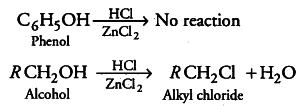Ask questions which are clear, concise and easy to understand.
Ask QuestionPosted by Vivek Chirmade 5 years, 2 months ago
- 0 answers
Posted by Pardeep Chaudhary 5 years, 2 months ago
- 3 answers
Devil ? 5 years, 2 months ago
Bbavya Mittal 5 years, 2 months ago
Rishika Neogi 5 years, 2 months ago
Posted by Shailaja Kamble 5 years, 2 months ago
- 0 answers
Posted by Anisha Kabsuri 5 years, 2 months ago
- 1 answers
Yogita Ingle 5 years, 2 months ago
Due to resonance in phenol, C— O bond of phenol has some partial double bond character, which strengthens the bond. So, it is difficult to break this C— O bond of phenol while the C— O bond of alcohol is purely single bond and comparatively weaker bond. So, alkyl halides can be prepared by the reaction of alcohols with HCl in the presence of ZnC{{l}_{2}} while aryl halides cannot be prepared by the reaction of phenol with HCl in the presence of ZnCl2.

Posted by Insha Khalid 5 years, 2 months ago
- 1 answers
Meghna Thapar 5 years, 2 months ago
The group 16 elements of modern periodic table consist of 5 elements oxygen, sulphur, selenium, tellurium and polonium. The elements in this group are also known as the chalcogens or the ore-forming elements because many elements can be extracted from the sulphide or oxide ores. The group VIA elements are called chalcogens because most ores of copper (Greek chalkos) are oxides or sulfides, and such ores contain traces of selenium and tellurium.
Posted by Pallavi Lama 5 years, 2 months ago
- 0 answers
Posted by Shree Ram Faujdar 5 years, 2 months ago
- 2 answers
Nancy Verma 5 years, 2 months ago
Satyam Jain 5 years, 2 months ago
Posted by Shanmugam S 5 years, 2 months ago
- 1 answers
Neha Neha 5 years, 2 months ago
Posted by Parth Pawar 5 years, 2 months ago
- 3 answers
Gauarav Raj 5 years, 2 months ago
Priyanshu Dubey 5 years, 2 months ago
Posted by Satish Kumar 5 years, 2 months ago
- 1 answers
Priyanshu Dubey 5 years, 2 months ago
Posted by Dgf Chd 5 years, 2 months ago
- 1 answers
Yogita Ingle 5 years, 2 months ago
USES OF DIOXYGEN
- Dioxygen is extremely vital for processes like combustion and respiration.
- Dioxygen is mixed with carbon dioxide or helium to be used for artificial respiration.
- It is used in the manufacture of many metals.
- It is highly used in oxy-acetylene welding and metal cutting.
- Dioxygen is used to oxidise ammonia in the manufacture of nitric acid.
- It is used in oxygen cylinders, which are widely used in hospitals, high-altitude flying and in mountaineering.
- Liquid oxygen is an important constituent of the fuel used in rockets.
Posted by Dgf Chd 5 years, 2 months ago
- 2 answers
Gaurav Seth 5 years, 2 months ago
O is the symbol of oxygen which has a valency of -2.
Each oxygen combines with the other to complete its octet.
Now, if one atom of O conbines with the other.they both need 2 electrons each to be stable.
Thus covalent bond are formed between the two atoms,and a diatomic molecule is formed.
This molecule is reffered to as di - oxygen.
Posted by Dgf Chd 5 years, 2 months ago
- 1 answers
Priyanshu Dubey 5 years, 2 months ago
Posted by Dgf Chd 5 years, 2 months ago
- 1 answers
Priyanshu Dubey 5 years, 2 months ago
Posted by Ayush Vishwakarma?? 5 years, 2 months ago
- 1 answers
Neha Neha 5 years, 2 months ago
Posted by Dgf Chd 5 years, 2 months ago
- 1 answers
Gaurav Seth 5 years, 2 months ago
Sulphuric acid is called the King of Chemicals because it is used in the preparation of a very large number of other useful chemicals such as hydrochloric acid, nitric acid, dyes, drugs etc. In fact the annual production of shulpuric acid in a country is a measure of the economy of the country.
Posted by Dgf Chd 5 years, 2 months ago
- 1 answers
Gaurav Seth 5 years, 2 months ago
Oxoacids are basically acids that contain the element oxygen. As such, Phosphorus is known to form a number of oxoacids, for example: H3PO4, H3PO3, etc. In oxoacids of phosphorus, it is tetrahedrally surrounded by other atoms. Generally, all these acids are known to form at least one P=O bond and one P–OH bond.
Posted by Dgf Chd 5 years, 2 months ago
- 0 answers
Posted by Dgf Chd 5 years, 2 months ago
- 0 answers
Posted by Dgf Chd 5 years, 2 months ago
- 1 answers
Gaurav Seth 5 years, 2 months ago
Ozone
It is represented as O3. It is found in upper atmosphere.
Preparation:
- It is prepared when ultraviolet rays. They react with oxygen of upper atmosphere and splits oxygen molecule in oxygen atoms. Then this oxygen atom combines with oxygen molecule to form ozone:
- 3O2 ---> 2O3
- Oxygen Ozone
- The reaction is endothermic approx. 142.7kJ of heat is needed.
- For preparing pure ozone we use ozoniser, in which the electric spark is passed through oxygen gas and we get ozone.
Posted by Dgf Chd 5 years, 2 months ago
- 1 answers
Gaurav Seth 5 years, 2 months ago
Dioxygen plays a vital part in the existence of life. It is a highly reactive non-metal and it is a member of the chalcogen group on the modern periodic table. Oxygen is diatomic molecule and hence two atoms of the elements combine to form dioxygen. It is the third most abundant element in the universe.
Around 21% of the earth’s atmosphere consists of this gas in its free state. Chemical formula of oxygen is O2. It is the most abundant element found in the earth’s crust.
Posted by Dgf Chd 5 years, 2 months ago
- 1 answers
Gaurav Seth 5 years, 2 months ago
Dioxygen plays a vital part in the existence of life. It is a highly reactive non-metal and it is a member of the chalcogen group on the modern periodic table. Oxygen is diatomic molecule and hence two atoms of the elements combine to form dioxygen. It is the third most abundant element in the universe.
Around 21% of the earth’s atmosphere consists of this gas in its free state. Chemical formula of oxygen is O2. It is the most abundant element found in the earth’s crust.
Posted by Dgf Chd 5 years, 2 months ago
- 2 answers
Pragati Gola 5 years, 2 months ago
Yogita Ingle 5 years, 2 months ago
Halides are binary compounds that are of which one part is an element another part is the halogen atom. A radical is less electronegative compared to that of halogens which form astatine, bromide, fluoride and chloride. Most of the salts are halides. Various halide compounds are tested using silver nitrate solution. Some include Kl, KBr, and KCl.
Posted by Dgf Chd 5 years, 2 months ago
- 1 answers
Yogita Ingle 5 years, 2 months ago
Acidic nature: Due to the decreasing bond dissociation enthalpy, acidic character of group 16 elements increases down the group.
H2O < H2S < H2Se < H2Te
Posted by Dgf Chd 5 years, 2 months ago
- 1 answers
Yogita Ingle 5 years, 2 months ago
- Electron Gain Enthalpy: The electron gain enthalpy decreases with increase in the size of the central atom moving down the group. Oxygen molecule has a less negative electron gain enthalpy than sulfur. This is on the grounds that Oxygen, because of its compressed nature encounter more repulsion between the electrons effectively present and the approaching electron.
Posted by Dgf Chd 5 years, 2 months ago
- 1 answers
Yogita Ingle 5 years, 2 months ago
- Ionization Enthalpy: Ionization enthalpy decreases with increase in the size of the central atom. Therefore, it decreases as we move from Oxygen to Polonium since the size of the atom increases as we move down.
Posted by Dgf Chd 5 years, 2 months ago
- 1 answers
Yogita Ingle 5 years, 2 months ago
- Atomic and Ionic Radii: The atomic and ionic radius increases as we move from Oxygen to Polonium.
Posted by Dgf Chd 5 years, 2 months ago
- 1 answers
Gaurav Seth 5 years, 2 months ago
The elements of group 15: oxygen (O), sulphur (S), selenium(Se), tellurium (Te) and polonium (Po) having general electronic configuration ns2np4, are known as the oxygen family. All these elements collectively are also known as chalcogens. Polonium is a radioactive element.
Posted by Dgf Chd 5 years, 2 months ago
- 1 answers
Yogita Ingle 5 years, 2 months ago
Element |
Electronic Configuration |
| Oxygen | [He] 2s2 2p4 |
| Sulphur | [Ne] 3s2 3p4 |
| Selenium | [Ar] 3d10 4s2 4p4 |
| Tellurium | [Kr] 4d10 5s2 5p4 |
| Polonium | [Xe] 4f14 5d10 6s2 6p4 |
Posted by Dgf Chd 5 years, 2 months ago
- 1 answers
Yogita Ingle 5 years, 2 months ago
Element |
Electronic Configuration |
| Oxygen | [He] 2s2 2p4 |
| Sulphur | [Ne] 3s2 3p4 |
| Selenium | [Ar] 3d10 4s2 4p4 |
| Tellurium | [Kr] 4d10 5s2 5p4 |
| Polonium | [Xe] 4f14 5d10 6s2 6p4 |

myCBSEguide
Trusted by 1 Crore+ Students

Test Generator
Create papers online. It's FREE.

CUET Mock Tests
75,000+ questions to practice only on myCBSEguide app
 myCBSEguide
myCBSEguide